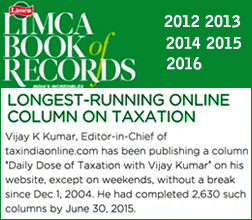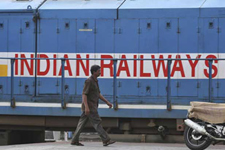Equalisation Levy Rules Notified
 TIOL-DDT 2857
TIOL-DDT 2857
31 05 2016
Tuesday
GOVERNMENT has notified the Equalisation Levy Rules, 2016. Equalisation Levy was introduced in the Finance Act 2016.
As per Section 165 of the Finance Act 2016, there shall be charged an equalisation levy at the rate of six per cent. of the amount of consideration for any specified service received or receivable by a person, being a non-resident from-
(i) a person resident in India and carrying on business or profession; or
(ii) a non-resident having a permanent establishment in India.
Every person, being a resident and carrying on business or profession or a non-resident having a permanent establishment in India (assessee) shall deduct the equalisation levy from the amount paid or payable to a nonresident in respect of the specified service, if the aggregate amount of consideration for specified service in a previous year exceeds one lakh rupees.
The Rules come into force on the 1st of June 2016.
As of now, the specified service means, online advertisement, any provision for digital advertising space or any other facility or service for the purpose of online advertisement and includes any other service as may be notified by the Central Government.
Some of these transactions may also attract reverse charge of Service Tax. How to compute this 6%? with addition of Service Tax? TDS is not required to be added for Service Tax. Why can't the CBEC and CBDT give an illustration?
CBDT Notification No.38/2016, Dated: May 27, 2016
Income Tax - Deduction of Bad Debt- No need to prove that debt is irrecoverable - CBDT Clarifies
DIRECT Tax Laws (Amendment) Act, 1987 amended the provisions of sections 36(1)(vii) and 36(2) of the Income Tax Act to rationalize the provisions regarding allowability of bad debt with effect from the 1st April, 1989.
The legislative intention behind the amendment was to eliminate litigation on the issue of the allowability of the bad debt by doing away with the requirement for the assessee to establish that the debt, has in fact, become irrecoverable.
Despite the amendment, disputes on the issue of allowability continue, mostly for the reason that the debt has not been established to be irrecoverable.
The Supreme Court in the case of TRF Ltd - 2010-TIOL-15-SC-IT, ruled that the position of law is well settled. "After 1.4.1989, for allowing deduction for the amount of any bad debt or part thereof under section 36(1) (vii) of the Act, it is not necessary for assessee to establish that the debt, in fact has become irrecoverable; it is enough if bad debt is written off as irrecoverable in the books of accounts of assessee."
Board clarifies that claim for any debt or part thereof in any previous year, shall be admissible under section 36(1)(vii) of the Act, if it is written off as irrecoverable in the books of accounts of the assessee for that previous year and it fulfills the conditions stipulated in sub section (2) of sub-section 36(2) of the Act.
Board has decided that no appeals will henceforth be filed on this ground and appeals already filed, if any, on this issue before various Courts/Tribunals will be withdrawn/not pressed upon.
CBDT Circular No. 12/2016., Dated: May 30, 2016
FTP - Amendment to Appendix 6H and ANF7A
DGFT has amended/corrected Appendix-6H and ANF7A of Appendices and Aayat Niryat Forms of FTP 2015-20, to be effective from the 1st of April, 2015.
Appendix - 6H -Procedure to be followed for reimbursement of Central Sales Tax (CST) on supplies made to Export Oriented Units (EOUs) and units in Electronic Hardware Technology Park (EHTP) and Software Technology Park (STP)]
ANF7A -Application for claim of TED Refund/Duty Drawback/Brand Rate Fixation.
DGFT Public Notice No. 14/2015-2020., Dated: May 30, 2016
Balance of CENVAT Credit on Shifting of Factory
RULE 10 of the CENVAT Credit Rules states,
"RULE 10. Transfer of CENVAT credit. - (1) If a manufacturer of the final products shifts his factory to another site or the factory is transferred on account of change in ownership or on account of sale, merger, amalgamation, lease or transfer of the factory to a joint venture with the specific provision for transfer of liabilities of such factory, then, the manufacturer shall be allowed to transfer the CENVAT credit lying unutilized in his accounts to such transferred, sold, merged, leased or amalgamated factory."
Though the rule appears to be quite clear, the Department had no doubt that credit can be carried forward by a unit only in the event of amalgamation or merger. Revenue denied the credit on the ground that Rule 10 of the CENVAT Credit Rules, 2004 does not permit a shifting unit which closes its business to claim unutilized CENVAT credit consequent upon shifting.
This was the issue before the CESTAT recently.
The CESTAT observed,
Bare perusal of sub-rule (1) of Rule 10 above throws light that while legislature contemplated that sale, merger, amalgamation, lease or transfer of a factory entitles the sold, merged, leased or amalgamated factory to avail the unutilized CENVAT credit lying in their account prior to such event, a shifted factory also stands in similar footing to avail such benefit.
Absence of the word "shifted" in the said sub-rule appears to be an inadvertence which does not lead to construe the provision therein to be denial proposition of law to grant the benefit of unutilized credit to a shifted factory. When the legislature has used the word "shifts" in the first part of the sentence in Rule 10(1), the word "shifted" may be construed to be a necessary implication thereof for the purpose of that rule in absence of any specific denial intention. Therefore, the said such Rule does not call for an interpretation in a pedantic manner.
It is well settled that law is to be interpreted in a manner to make that workable without creating any absurdity or ambiguity. Therefore, a shifted unit if dealt discriminately under Rule 10(1) of CENVAT credit Rules, 2004, use of the word "shifts" in the beginning part of the said sub-rule shall be otiose.
The CESTAT had a suggestion for the Department: take up the matter with the Government for appropriate legislative measure in sub-rule (1) of Rule 10 of CENVAT Credit Rules, 2004 to achieve the legislative mandate of shifting of a factory for any internal, external or statutory reasons.
Please see Breaking News for the case.
KKC - it is Finance Act, 2016
YESTERDAY, DDT reported -
Krishi Kalyan Cess - Board Bungles Year
KRISHI KALYAN Cess is imposed by the Finance Act 2016, but Board seems to think otherwise.
In Circular No. 194/04/2016-ST, dated 26.05.2016, the CBEC states, "Chapter VI of the Finance Act, 2015 will come into effect from 1st June, 2016". What the Board means is obviously 'Finance Act 2016' and not 2015.
Advantage of technology is that the Board can retrospectively correct its mistakes with hardly anyone noticing. The Board will correct this mistake silently in their website, but all those who have downloaded it, printed it and distributed it will look guilty.
On Friday, we pointed out that there was a mistake in paragraph numbering in the same Circular, which the Board silently corrected.
True to what DDT had prophesied, around noon, the Board stealthily changed the year to 2016.
Indirect Tax DRS, 2016
CHAPTER XI of the Finance Act, 2016 provides the legal framework for the The Indirect Tax Dispute Resolution Scheme, 2016 which comes into operation from tomorrow.
Whereas the CBDT appears to be fully geared up to cobble Direct Taxes through this scheme and has issued the Direct Tax Dispute Resolution Scheme Rules, 2016 on 26.05.2016 by notification 35/2016 and launched a Publicity campaign, the CBEC is sadly wanting on the execution front. In fact, the CBDT had issued a Press Release on 12th May 2016 requesting the stakeholders and general public to bring out issues/points which in their opinion would require further clarification/guidance [See DDT 2845].
Hopefully, the CBEC has not altogether forgotten about it. Rules are to be made for carrying out the provisions of the Scheme, form and manner of declaration is to be prescribed and all this has to be done by today for the scheme is to become operational tomorrow.
Perhaps, today evening the notification and Circular would be issued.
It seems that the Board is not that enthusiastic about the Scheme for the TRU letter D.O.F. No.334/8/2016-TRU dated February 29, 2016 makes a passing remark about the scheme in the following manner -
15.5 Indirect tax Dispute Resolution Scheme, 2016
Indirect tax Dispute Resolution Scheme, 2016, wherein a scheme in respect of cases pending before Commissioner (Appeals), the assessee, after paying the duty, interest and penalty equivalent to 25% of duty, can file a declaration, is being introduced. In such cases the proceedings against the assessee will be closed and he will also get immunity from prosecution. However, this scheme will not apply in certain specified type of cases.
To understand more about the Dispute Resolution Scheme which itself may become mired in many disputes, read -
Indirect Tax DRS, 2016 - another ploy to earn Revenue
Indirect Tax Dispute Resolution Scheme, 2016
Has Budget 2016 helped much in reducing scope of vexatious litigation?
New Dispute Resolution Scheme, 2016 in CBDT and CBEC
Indirect Tax Dispute Resolution Scheme, 2016 - will this really result in reduction of litigation?
Until Tomorrow with more DDT
Have a nice day.
Mail your comments to vijaywrite@tiol.in
















